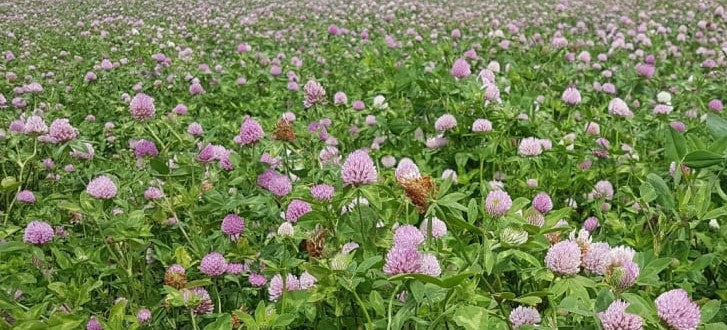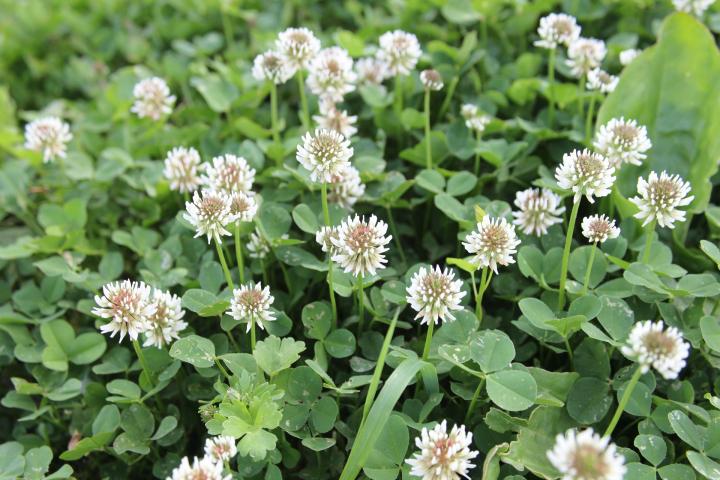Clover for Grassland - Red & White
Clover for Grassland - Red & White
Couldn't load pickup availability
Clover can be grown as a monoculture or part of a multi sward mixture. One of the many benefits of having clover in a multi species mix is that is provides nutritional forage when grasses are less productive i.e. summer months or during drought.
Benefits of Clover in your pasture:
- High Yielding Forage - Clover yields are similar to the high sugar grass varieties. Well maintained pasture with clover will produce 10-15 tonnes Dry Matter per Hectare per year.
- Home Grown Traceable Protein - Clovers are high in DUP. This is the protein that is available to the rumen and intestine. The more digestible the protein the better milk production in dairy cows, quicker weight gain in beef cattle and lambs. Therefore more profitable dairy cows and quicker finishing dates for lambs and beef cattle.
- Highly Palatable - all year round palatability and highly digestible there fore livestock more inclined to eat more and so weight gain easier to reach in shorter time periods.
- Source of Nitrogen - Clover can fix up to 250kg of Nitrogen per hectare per year. Between 75-100kg of this is transferred to the surrounding grass. Maintenance of N levels is less costly compared to grass only mixture.
- Improved Summer Grazing Productivity - Clover is still highly productive and nutritious during the summer months when grasses tend to be dormant.
- Extended Grazing Period - Mixing a cool season clover with warm season grasses will improve the quality of feed at either end of grass growing season as clovers are winter hardy.
- Persistency - Persistency of clovers is improving all the time, there are now varieties of red clover that will last 4-5 years in a mix as long as the grass land is well managed.
- Drought Resistant - Red Clover's deep tap root can grow down 2 meters. It can access water deep down in soil structure, this helps it to stay healthy even during drought conditions. So when grass dies down during dry spells the red clover will still be providing livestock with fresh, green nutritious forage.
- Improves Soil Structure - White clover has wide spreading roots along top soil layer, these hold top soil together. Red clover has a deep tap root, this can break up soil compaction deep below the surface and improve soil tilth in heavy clay soils. Improvement of soil tilth increases the nutrient movement therefore improving nutrient uptake of the grass roots.
Which Clover for which farming practice:
- Red Clover - Great for silage mixes and finishing lambs.
- White clover - If for cutting/silage then use large leaf varieties to get the most out of the clover qualities. For grazing and cutting then medium leaf varieties withstand both practices. If only grazing sheep and cattle then small leaf variety is the best option.
Be careful of:
- Red Clover for cattle grazing as there is an increased risk of bloating. This is due to the rapid breakdown of protein in clover which leads to the build-up of excessive gas in the rumen. Effective stock/pasture management can minimise this risk.
- Red Clover contains phytoestrogens, this can cause hormonal imbalances. Avoid grazing breeding ewes 6 weeks either side of mating.
- Protect the crown, do not cut or graze below 7cm. Crown protection is important for longevity of the overall plant. If the crown is damaged the clover will die out.
- Clover dominance is when the clover is outcompeting the grass sward. This can be prevented by avoiding too regular a silage cut as regular removal of N encourages the clover. If clover dominance has occurred then heavy sheep grazing will suppress the clover growth.
- Pests & disease, crop rotation will keep the risk of stem nematode and sclerotinia to a minimum.
Benefits of Clover for the environment:
Clover provides a home grown source of slow release Nitrogen. It also provides pollen and nectar for Bumblebees, Honey Bees, Butterflies, Hoverflies and other pollinating insects. Pollinating insects are considered to be in decline. By sowing clover, a pollen rich flower, over a long season this can help reduce this trend. The increase of pollinating insects in your area will ensure plants continue to reproduce through seed and that many fruit and vegetable crops successfully set fruit.
Ground Preparation, Sowing & Maintenance:
- It is very important to start with a clean seed bed. It needs to be weed free with the pH and nutrient levels all at the right balance.
- Soil pH around 6.0 or above. If soil needs lime add this well in advance.
- P & K needs to be 50-120kg/ha at establishment.
- If in multi species mix on bare ground then broadcast and roll 3 times to ensure good soil to seed contact.
- If over seeding clover in established grass sward then can broadcast or direct drill - only 5-10mm deep in open swards. If broadcast roll 3 times to ensure seed embedded into soil surface.
- Sowing rate for over seed into current pasture is 1 - 2kg per acre to avoid clover dominance.
- Graze swards lightly in the autumn of the sowing year.
- Depending on when sown, 1st cut is between 20th May - 10th June.
- Cut when there are 50% flower buds - cut at early bud stage to obtain the best quality and yield. You should get 4 cuts at 6-8 week intervals. Be careful not to cut below 7cm as this will damage the crown.
- Graze autumn regrowth.
- Allow the clover to flower once a year.
Sowing rate: Over seed 1-2kg/acre
Monoculture Red Clover 6kg/a
Monoculture White Clover 4kg/a
Please contact us to discuss your needs - 01786 834422 or email alan@grassseed.co.uk




